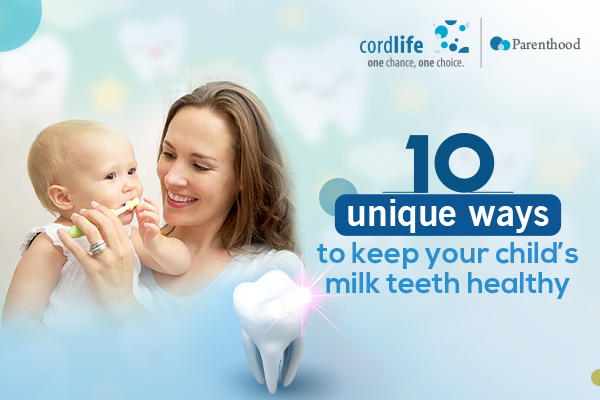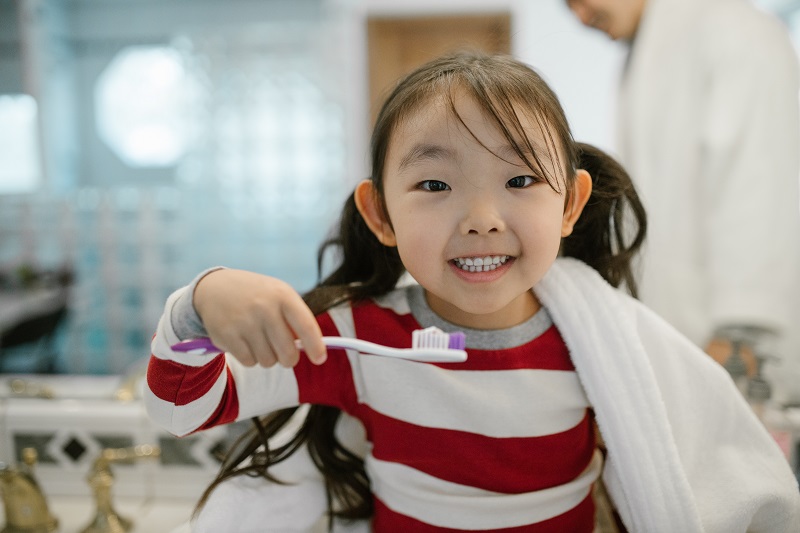Table of Contents
- Gently Massage Your Little One’s Gum
- Use The Cool Teething Rings
- Use Sugar-free Teething Biscuits
- Try To Keep The Drool Dry
- Use Toothbrushes Designed Especially For Babies Under 2 Years
- Keep Your Child In A Comfortable Position While Brushing The Teeth
- Be Careful With The Teething Gels When It Comes To Your Child’s Oral Health Care
- Early Tooth Decay Is Not Uncommon During The Time Of Your Baby’s Teeth Growth
- Dental Formula Of Your Child
- Make Your Child Understand That Losing Teeth Is A Natural Process
Did you know that your infant had teeth, while she was still curled up in your womb? At about 5 weeks gestation, the first buds of primary teeth appear. At birth, your newborn will have a full set of 20 primary teeth hidden under his or her gummy smile.
By the time the 20 milk teeth appear, there are chances that he or she will show signs of mild irritability, fussiness, drooling, runny nose, diarrhoea, a low-level fever and an urge to chew something hard. We know that such times are really difficult for you as a new mom.
Take the help of your child’s dentist during such times and read this informative article to follow the child dental care tips.
Gently Massage Your Little One’s Gum
Your little one’s gum is delicate. Use either your fingers or a soft and wet cloth for massaging. Make sure you have clean fingers when you’re massaging the gums.
Use The Cool Teething Rings
Since your child is feeling the urge to chew on something, he or she might also feel cranky out of pain in the gum. Pressure from a relatively cool object might give your little one some relief. Ensure you do not sterilize the plastic rings unless you’ve been specified by the manufacturer.
Use Sugar-free Teething Biscuits
If your little one has already started on solid food, these biscuits will give some relief to your baby’s teeth.
Try To Keep The Drool Dry
Drooling is common in young children, especially while their teeth are coming in. It is usually nothing to worry about. However, excessive saliva can sometimes irritate a baby’s skin and cause drool rash. The saliva can be very irritating for your little one. Keep the drool dry by gently wiping it away with a soft cloth.
Use Toothbrushes Designed Especially For Babies Under 2 Years
As soon as you notice your baby’s first two pearly whites emerge, clean them with these toothbrushes.
- Use only water on the toothbrush to brush your baby’s teeth at the initial stages. At least, till such time that your baby is 18 months old or till the time the dentist advises some other option for the child.
- You could also make brushing creative, interesting, and fun by singing songs or by allowing your sweet chubby baby to play with his or her favorite toys.
- Clean the brush with plain water, once you’ve cleaned your baby’s teeth and gums.
- Keep the toothbrush upright, and in the open air so that it dries up easily before using it for the next time.
- Change the toothbrush after every 3 – 4 months once the bristles are worn out.
Keep Your Child In A Comfortable Position While Brushing The Teeth
While you’re cleaning your little one’s mouth, keep your baby in such a position so that your baby feels secured and you can see his or her mouth clearly. You can either sit on the floor or on your bed, and can keep your baby’s head on your lap. Keep your child’s chin cupped in your hands and his or her teeth in soft and circular motion, by lifting his or her lip up. Ensure that you spend more time on each tooth of your baby’s gum – be it in the front or back.
Be Careful With The Teething Gels When It Comes To Your Child’s Oral Health Care
Try to choose those gels which wouldn’t have 8.7% to 9.0% of choline salicylate in them, which basically is aspirin. Aspirin is not recommended in children under 16 years old.
Early Tooth Decay Is Not Uncommon During The Time Of Your Baby’s Teeth Growth
It occurs when the germs attack your baby’s teeth and damages the surface. Tooth decay is basically, a diet-related problem, which can cause pain and infection in your baby and can even affect the overall development of the baby. You can treat the decay by:
- Visiting the dentist by your baby’s first birthday and spotting the early signs of decay.
- The method of feeding your baby is also very important. Once your baby is old enough to have solid food don’t give foods rich in high sugar.
- Once the second tooth comes out, help your child floss. Oral hygiene for a child is incomplete without flossing.
Dental Formula Of Your Child
The exact time of your infant’s teeth growth might differ from that of another baby. While some babies start teething as early as 2 or 3 months, there are some babies who don’t cut their first tooth until they are 12 months or more. A full set of 20 milk teeth or primary teeth which remains hidden at the time of birth, appears within a few years of your baby’s life and the dental formula of a child goes like this:
- First molars – between 6 and 7 years.
- Central incisors – between 6 and 8 years.
- Lateral incisors – between 7 and 8 years.
- Canine teeth – between 9 and 13 years.
- Premolars – between 9 and 13 years.
- Second molars – between 11 and 13 years.
- Third molars (wisdom teeth) – between the ages of 17 and 21 years, if at all.
Make Your Child Understand That Losing Teeth Is A Natural Process
By the time your little one is 6 years old, your child’s teeth may feel a little wobbly and tend to fall out to make way for permanent teeth. Your child might even lose the first tooth before or later than 6 years old. Although losing teeth might be painful for your child, you can make your child understand that losing baby teeth is a natural process. As a part of your child’s dental care, you can use cold packs or pain-relief medicine. It is also a good idea to reward your child to help him or her to take the idea of tooth loss easily. (However, if your child is under 6 years old rice-sized smear of toothpaste will be helpful for your child. But if your child is above 6 years old fluoride-based toothpaste will work best).
Dental Hygiene is important for your child. Healthy milk teeth can help your child to eat, chew and speak normally. It can further help in your child’s growth and development. Keeping the above points in mind will help you in taking care of your child’s dental health. Also, don’t forget to take your child to the dentist to address any of his or her teeth problems.
Visit the blog page of Cordlife India to learn more about pregnancy, childbirth, parenting, and cord blood banking.

